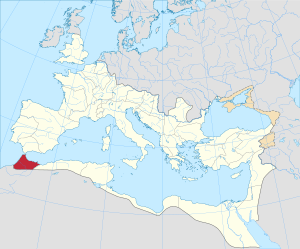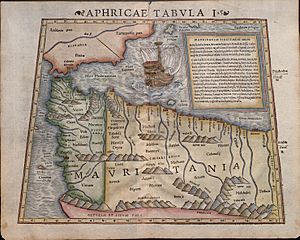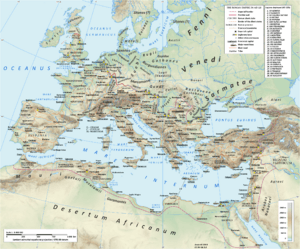Mauretania Tingitana facts for kids
Quick facts for kids Provincia Mauretania Tingitana |
|||||||||||||
|---|---|---|---|---|---|---|---|---|---|---|---|---|---|
| Province of the Roman Empire | |||||||||||||
| 42 AD–Late 7th century | |||||||||||||
 The province of Mauretania Tingitana within the Roman Empire, c. 125 AD |
|||||||||||||
| Capital | Tingis, Septem | ||||||||||||
| Historical era | Classical Antiquity, Late Antiquity | ||||||||||||
|
• Incorporated into the Roman Empire as a full province
|
42 AD | ||||||||||||
|
• Vandal Conquest
|
430s AD | ||||||||||||
|
• Byzantine partial reconquest by Vandalic War
|
534 AD | ||||||||||||
| Late 7th century | |||||||||||||
|
|||||||||||||
| Today part of | Morocco Spain: Ceuta Melilla Plazas de soberanía |
||||||||||||

|
Part of a series on the
|
|---|
| History of Morocco |
 |
|
|
Classical to Late Antiquity
(8th century BC – 7th century AD)
|
|
|
|
|
|
|
Related topics
|
Mauretania Tingitana was an important Roman province in ancient times. Its name comes from the Latin for "Tangerine Mauretania." This area is roughly the northern part of modern-day Morocco.
The province stretched from the northern tip of Africa, across from Gibraltar. It went south to cities like Sala Colonia and Volubilis. To the east, it reached the Mulucha (or Malva) river. The main city and capital was Tingis, which is known today as Tangier. Other key cities included Iulia Valentia Banasa, Septem, Rusadir, Lixus, and Tamuda.
Contents
History of Mauretania Tingitana

Becoming a Roman Province
In 40 AD, the last ruler of the Kingdom of Mauretania, Ptolemy, died. Around 44 AD, the Roman Emperor Claudius took control of the kingdom. He divided it into two new Roman provinces: Mauretania Tingitana and Mauretania Caesariensis. The Mulucha River, about 60 km west of modern Oran in Algeria, became the border between them.
Roman Control and Borders
The Romans did not control all of the land very far inland. In the west, their southern border was near Volubilis. This city was surrounded by military camps and a defensive ditch. On the Atlantic coast, Sala Colonia was also protected by a ditch and watchtowers.
This was not a single, long wall like in Roman Britain. Instead, it was a network of forts and ditches. This system, called the limes (where the word "limit" comes from), helped control who entered and left Roman areas. It managed trade and contact between local people and Roman towns.
The population in these areas was not very large. Volubilis, for example, had about 20,000 people at its peak. Only a small part of them were from Europe, mostly Spain. Most people were local.
Some Roman historians believed that all of Morocco north of the Atlas Mountains was part of the Roman Empire. This was because Mauretania was a "vassal state" (a state that had to obey Rome) under Emperor Augustus. Its rulers controlled areas south of Volubilis. However, Roman soldiers mainly controlled up to Sala Colonia. Some historians even think the Roman border reached the area of Casablanca.
Pliny the Elder, a Roman writer, described an expedition by a Roman general, Gaius Suetonius Paulinus, in 41 AD. Paulinus traveled beyond the Atlas Mountains. He wrote about tall, unknown trees with smooth trunks and cypress-like leaves. He also mentioned that the mountain peaks had snow even in summer. He described deserts with black sand and rocks that looked like they had been burned.
Life in the Roman Province
During the rule of King Juba II, Emperor Augustus had already started three Roman settlements (called colonias) in Mauretania. These were Iulia Constantia Zilil, Iulia Valentia Banasa, and Iulia Campestris Babba. These cities were close to the Atlantic coast.
This western part of Mauretania later became the province of Mauretania Tingitana. It remained part of the Roman Empire until 429 AD. That's when the Vandals took over the area, and Roman rule ended.

The most important city in Mauretania Tingitana was Volubilis. It was the main center for government and trade in western Roman Africa. The land was very fertile, producing crops like grain and olive oil. These goods were sent to Rome, making the province wealthy. There is also evidence that a Jewish community lived there during Roman times.
Mauretania Tingitana mainly exported purple dyes and valuable wood. It also sent farm products and animals like lions and leopards to Rome. The local people, called the Mauri, were skilled soldiers. The Romans often recruited them, especially as light cavalry (soldiers on horseback).
Changes and Challenges
In 297 AD, Emperor Diocletian reorganized the Roman government. Mauretania Tingitana became part of the "Diocese of Hispaniae" (the Spains). This meant it was linked to Roman lands across the sea in Europe.
The Germanic Vandals settled in Spain in 422 AD. From there, they started attacking Mauretania Tingitana. In 427 AD, a Roman general named Bonifacius refused an order from Emperor Valentinian III. He invited the Vandal king, Gaiseric, to Africa. Bonifacius provided ships for the Vandals to cross to Tingis and Septem. He wanted to keep them in Mauretania, but once they crossed, they marched on to Carthage.
Byzantine and Muslim Rule
In 533 AD, the Byzantine general Belisarius reconquered parts of North Africa from the Vandals. Most of the western territory had already been lost to the local Berber people. However, the Byzantines kept a military unit at Septem (modern Ceuta). This was their last outpost in Mauretania Tingitana. The rest of the former Roman province joined the Byzantine part of Spain.
Later, the Umayyad Caliphate conquered all of North Africa. They brought Islam to the local people, who had followed traditional Berber religions or Christianity. The two Mauretania provinces became part of a larger territory called al-Maghrib. This is the Arabic name for 'the West', and it is still the official name of Morocco today.
Today, you can still see stone ruins from the Roman era. These include the Capitoline Temple at Volubilis, the palace of Gordius, Sala Colonia, Tingis, and Iulia Constantia Zilil.
See also
 In Spanish: Mauritania Tingitana para niños
In Spanish: Mauritania Tingitana para niños
- List of Roman governors of Mauretania Tingitana
- Mauretania Sitifensis
- Mauretania Caesariensis
- Roman roads in Morocco
- Tabula Banasitana

